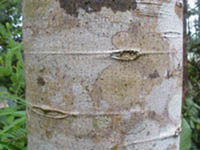
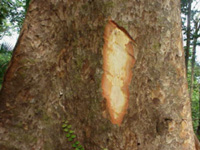
|
Emergent trees - Trees that noticeably extend beyond the canopy of the forest Large trees - Trees that make up the canopy of the forest. Small trees - Sub-canopy sized trees |
| cylindrical (or sub-cylindrical) in cross-section | markedly fluted in cross-section |
 |
 |
| straight (or only very slightly crooked) | (markedly) crooked |
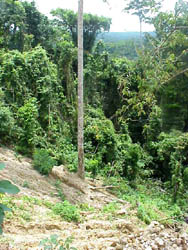 |
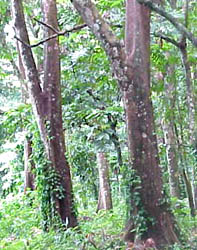 |
| This feature is recorded as either: present absent |
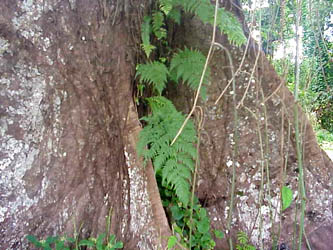 |
|
It is recorded as either: present absent |
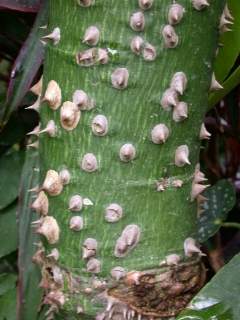
|
| Whether the spines occur: on the trunk on the branches |
| The aerial roots are recorded as either: present absent |
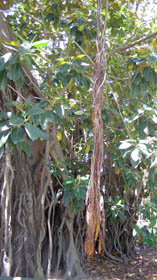
|
| Stilt roots are either recorded as: present absent |
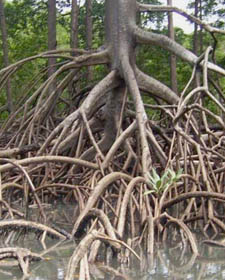
|
| The terminal developing buds are recorded as either: enclosed, or not enclosed |
|
The colour types include: white cream yellow green orange red grey brown black |
Note: a mixture if these colour types are frequently present.
| rough The surface of the bark should be rough to touch and may vary from finely to coarsely rough |
smooth Frequently, trees that have smooth bark may also be slightly flakey (as in the species illustrated here). However, if the majority of the surface of the bark is smooth to touch, then it is recorded as 'smooth'. |
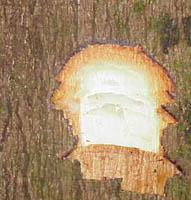
|
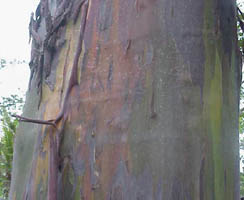 |
| scaly or flaky Since these two type of bark roughness are sometimes difficult to distinguish from each other, both categories are here grouped together. Flaky bark (eg. Heritiera trifoliolata) consists of many regular to subregular, thin flakes. Scaly bark (eg. Mangifera minor) is structurally similar, but usually thinner and not as regular as the flakes of the former example. Artocarpus vriesiana has scaly or flaky bark. |
fissured Fissured bark is finely split into many narrow grooves (eg. Dysoxylum inopinatum) |
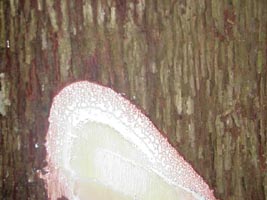
|
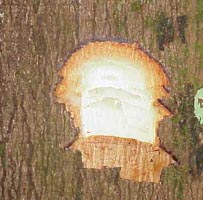
|
| peeling The bark splits or crack and then falls away in thin patches, sheets or long ribbons. The surface of the bark underneath the peeling layer is usually very smooth (eg Eucalyptus deglupta) |
cracked The outer surface of the bark is more or less smooth but it is divided into irregular plate-like areas by relatively broad cracks |
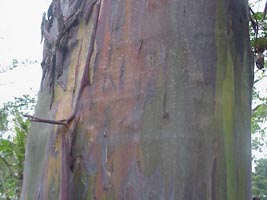
|
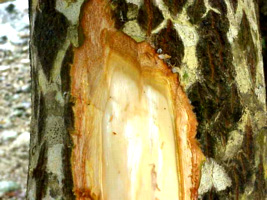
|
| furrowed cork Bark with relatively long narrow depressions or grooves (eg. bark of the introduced Pinus caribaea) |
pustular The bark is more or less covered with raised, rough, irregular bumps or lines of pustules/lenticels. In between the pustules, the surface of the bark is usually smooth or almost smooth (eg. Alstonia scholaris) |
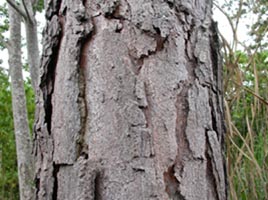
|
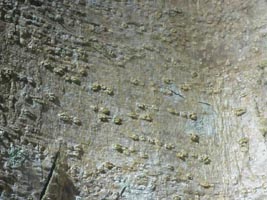
|
| tessellated The outer bark is finely divided into more or less regular square-like pieces so that it has a 'chequered' appearance. Note: the pieces do not detach readily (eg. Rhus taitensis). |
pitted The bark usually has small sunken pits with the general surface of the bark more or less smooth (eg. Dracontomelum lenticulatum) |
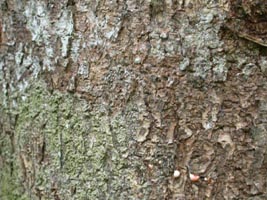
|
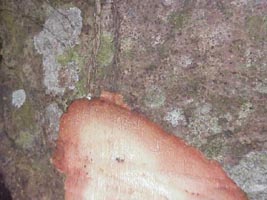
|
| elongated laterally The lenticels are arranged laterally across the trunk forming a raised more or less horizontal lines of pustules |
elongated vertically Lenticels are arranged vertically alon the trunk forming a raised more or less vertical lines of pustules |
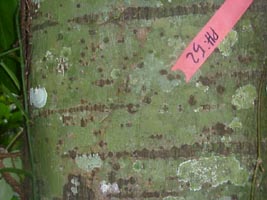
|
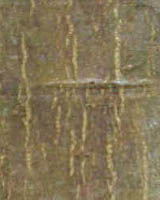
|
| rounded/swellings Lenticels more or less form globular (rounded) raised swellings on the surface (eg.Alstonia scholaris) |
irregular Lenticels do not form any of the above arrangements as they are irregular in shape and orientation |
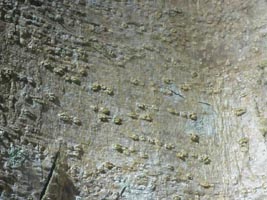
|

|
| The colour types include: white yellow orange green red brown black mottled |
This feature includes the total bark thickness, that is, both outer and inner bark
| This feature records whether the bark is thick or thin: <25 mm thick (namely, less than 25 mm thick; hence, thin) >25 mm thick (namely, greater than 25 mm thick; hence, thick) |
This standard for differentiating between thick and thin bark, as used in Australia,
has proved to be less useful in Papua New Guinea. It has been found that most
Papua New Guinean trees have thin bark, based on this classification system.
Although this feature is still included in this first version of the Guide to Trees of Papua New Guinea,
it will either be redefined or replaced by the following bark thickness measurement (mm)
feature in future versions.
| one layer | two layer Note: both an inner and outer layer can be distinguished. The layers are most commonly identified by differences in colour |
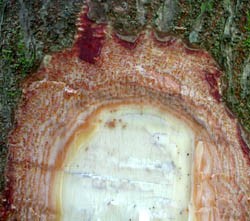
|
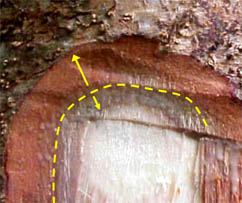
|
| The bark is either: faintly to non-aromatic, or strongly aromatic |
Note: Since the aroma of the bark is frequently only fully developed in mature trees,
it is recommended that caution be used when attempting to categorise the aroma of
bark on trees with a trunk of less than 50 cm in diameter at breast height (dbh)
(approximately 1.3 m above ground).
| unpleasant onion-like cinnamon-like resinous/linament-like spice-like pleasant pine-like almond-like |
Note: this feature is relatively subjective since the recognition of different aromas
are dependent on the individual. Therefore, this character should be used with caution.
The two general categories, pleasant and unpleasant have been included
when it is difficult to determine which of the other categories best describe the odour.
Please note that the above descriptors are not mutually exclusive.
| The colours of the outer blaze that are recognised include: white yellow orange pink red brown black green mixed colours grey |
Note: the category mixed colours is used when several (usually more than 2) different colours are present
| markings absent | speckled - marking more or less as wide as long, hence like dots | with stripes - markings distinctly longer than wide, hence like lines |
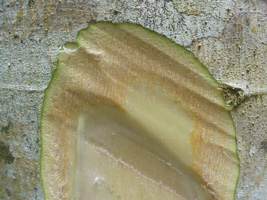 |
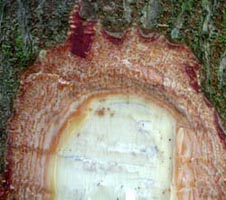 |
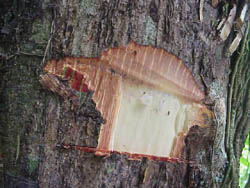 |
| smooth - hence, lacking any texture | fibrous - texture consisting of long fibrous groupings of cells |
 |
 |
| granular with splinters - bark crumbling into small blocks of cells with long splinter-like pieces of bark amongst granules | granular without splinters - all the outer bark crumbles into small blocks of cells. The long splinter-like pieces of bark are absent from this layer |
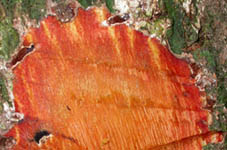 |
 |
| corky - very light, more or less smooth bark, frequently relatively thick, similar in texture to corks used in bottles | |
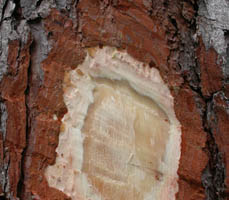 |
| The colours of the inner blaze that are recognised include: white yellow orange pink red brown black green mixed colours grey |
Note: the category mixed colours is used when several (usually more than 2) different colours are present.
| markings absent | speckled - marking more or less as wide as long, hence like dots | with stripes - markings distinctly longer than wide, hence like lines |
 |
 |
 |
| smooth - hence, lacking any texture | fibrous - texture consisting of long fibrous groupings of cells |
 |
 |
| granular with splinters - bark crumbling into small blocks of cells with long splinter-like pieces of bark amongst granules | granular without splinters - all the inner bark crumbles into small blocks of cells. The long splinter-like pieces of bark are absent from this layer |
 |
 |
| corky - very light, more or less smooth bark, frequently relatively thick, similar in texture to corks used in bottles | |
 |
| This feature is recorded as either: present, or absent |
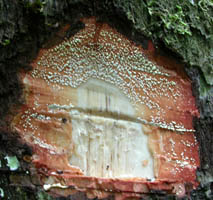
|
| The following colours are recognised: white/milky yellow red brown colourless (lacking colour/clear, often watery) green blue |
Since the colour of the sap may change rapidly once exposed to the air by the cut,
the sap colour should be recorded immediately.
| flowing- Soon after the blaze is cut, the exudate/sap flows abundantly | spotty, not readily flowing- The exudate/sap usually takes awhile to appear, but even when it appears immediately, it does not readily flow (hence referred to as spotty) | 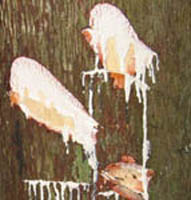
| 
|
| The two values of this feature are: colour changing on exposure to air, or colour not changing on exposure to air
|
| The following colours are recognised: grey orange brown black golden-coloured red green |
| sticky when touched, or not sticky. |
| Complex hairs are recorded as either: present or, absent |
| Disk-shaped - (peltate) the axis of the hair terminating in a more or less flattened disk of tissue, with the axis attached to the centre of the disk | Star-like - (stellate) the hair is once-branched with each branch radiating out from a single point | T-shaped - the hair terminates in two branches that approximately at right angles to the hairs axis | 
|

|

|
| Club-shaped - the hairs are swollen towards the apex of the hair such that the hair appears obovoid. | Head-like - (capitate) the hairs terminate in a small more or less globular swelling | Awl-like - the hairs are narrow and gradually tapering to a fine point | 
|

|

|
| Stinging hairs are recorded as either: present or, absent |
| Indumentum (hairs) are recorded as either: present or, absent on the mature twigs. |
| dense, or sparse |
Note: This feature is often best observed through a 10X hand lens.
When the indumentum is dense, the hairs are usually easily observed,
even when the hairs are short. However, when the indumentum is sparse,
the hairs may sometimes be difficult to see.